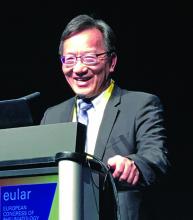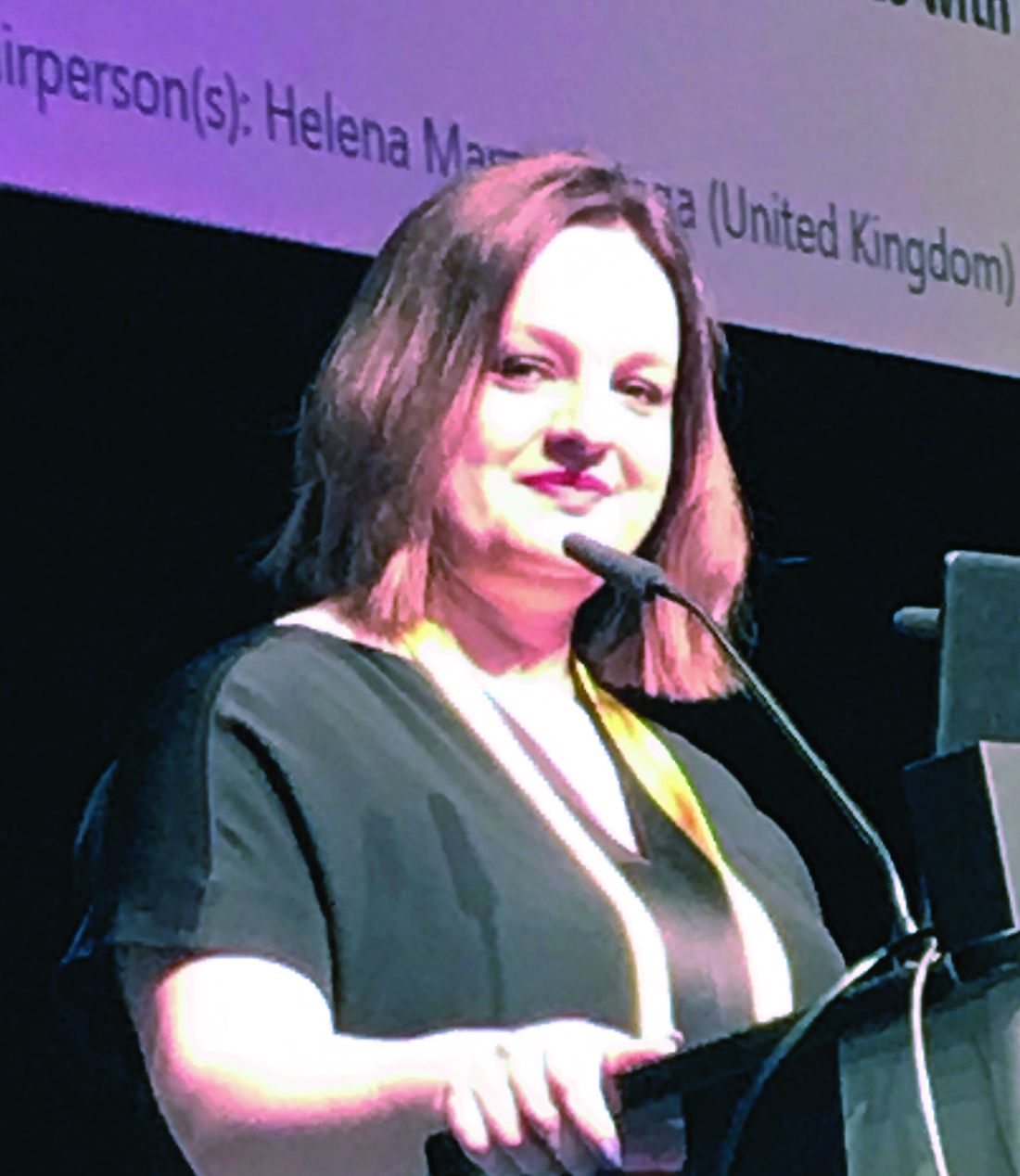User login
MADRID – Trial results presented at the European Congress of Rheumatology for three anti–interleukin-17 receptor monoclonal antibodies under investigation for the treatment of axial spondyloarthritis (axSpA), including one for ankylosing spondylitis (AS), appear to support further clinical development and regulatory review to potentially join secukinumab (Cosentyx) and ixekizumab (Taltz) as the only IL-17 inhibitors to be licensed for rheumatic diseases.
Both netakimab and brodalumab (Siliq) achieved positive results in separate phase 3 trials for the treatment of axSpA, while new data from a phase 2b trial of bimekizumab was associated with improvement in the quality of life of patients with AS. Brodalumab is already approved by the Food and Drug Administration for treating moderate to severe plaque psoriasis.
Netakimab
The multinational, double-blind, phase 3 trial with netakimab, called the ASTERA trial, randomized 228 patients with radiographic axSpA to either 120 mg of the experimental agent or placebo, each administered subcutaneously in weekly doses in the first 2 weeks and then every other week thereafter. The primary endpoint was a 40% improvement in Assessment of SpondyloArthritis International Society response criteria (ASAS40) at week 16.
A larger proportion of patients in the netakimab arm met the primary endpoint, compared with those in the placebo arm (40.4% vs. 2.63%, respectively; P less than .0001), reported Inna Gaydukova, MD, of Mechnikov North-Western State Medical University, St. Petersburg, Russia.
“Most of the secondary efficacy endpoints also showed a significant advantage for netakimab relative to placebo by week 4, and these advantages remained significant for the remainder of the study,” she said.
The one serious adverse event in the study occurred in the placebo arm. Although mild to moderate anemia and neutropenia were associated with treatment, the drug was well tolerated overall.
“We did observe a significant reduction in inflammatory activity in the spine with MRI at week 16,” Dr. Gaydukova added. Functional improvements in the experimental arm relative to the placebo arm were also observed, although Dr. Gaydukova acknowledged that longer trials are needed to show that these benefits are durable.
Brodalumab
The results of a multinational, double-blind, phase 3 trial with brodalumab proved similar to those with netakimab. Conducted in Taiwan, Japan, and South Korea, the trial randomized 159 patients to 210 mg of brodalumab or placebo administered subcutaneously. The therapies were administered on the same schedule as in the netakimab trial. The primary outcome was also the same.
At week 16, 43.8% of those on the experimental agent versus 24.1% of those randomized to placebo achieved ASAS40 (P = .018). As in the netakimab study, greater activity with brodalumab than placebo was also seen on several secondary outcomes, such as ASAS20 (67.5% vs. 41.8%).
“In a subgroup analysis, there was an advantage for brodalumab over placebo whether or not patients had prior experience with a TNF [tumor necrosis factor] inhibitor, regardless of baseline hs-CRP [high sensitivity C-reactive protein] level and independent of HLA type,” reported James Cheng-Chung Wei, MD, of Chung Shan Medical University Hospital, Taichung, Taiwan.
There were no significant differences in the types or rates of adverse events, including serious adverse events, in patients assigned to brodalumab relative to placebo. Suicide ideation, which has been associated with some biologics targeting other immunologic mediators, was evaluated but not seen.
“We think brodalumab has the potential to be a new therapeutic option in axSpA,” said Dr. Wei, who reported that studies in AS are also planned.
Bimekizumab
Additional 12-week outcome data from the multinational, double-blind, phase 2b BE AGILE trial of bimekizumab in patients with active AS were presented by Désirée van der Heijde, MD, PhD, of Leiden (the Netherlands) University Medical Center.
Unlike secukinumab and most of the other anti–IL-17 receptor monoclonal antibodies in development, bimekizumab inhibits IL-17F in addition to IL-17A, according to Dr. van der Heijde. She cited experimental evidence suggesting that inhibition of both forms of IL-17 results in greater anti-inflammatory response.
In the initial and previously reported data from this dose-ranging study of 303 AS patients, all four doses of bimekizumab (16 mg, 64 mg, 160 mg, or 320 mg) were superior to placebo for the primary endpoint of ASAS40. However, greater relative benefit was observed for the three highest doses.
In the new analysis, symptoms were evaluated with the Bath Ankylosing Spondylitis Disease Activity Index (BASDAI). At 12 weeks, 47.5% of patients on the highest dose of bimekizumab versus only 11.9% of patients randomized to placebo achieved a 50% or greater level of improvement on the BASDAI, called BASDAI 50 (P less than .001).
The greater clinical activity of bimekizumab relative to placebo translated into improvement from baseline in Ankylosing Spondylitis Quality of Life scores. Greater reductions in Ankylosing Spondylitis Quality of Life scores relative to placebo, signaling an improved quality of life, were achieved with all doses, but they reached 4.6 points for the highest dose versus only 1.3 for placebo.
When evaluated with Patient Global Assessment of Disease Activity, another tool that reflects perception of disease burden, the score reduction was 3.3 points for the highest dose versus 1.0 points for placebo. Dr. van der Heijde characterized the reductions at the highest doses versus placebo as “significant” although she did not provide P values.
Like the data presented on the other newer anti–IL-17 therapies, bimekizumab was well tolerated with relatively low rates of adverse events, most of which were mild to moderate in severity, according to Dr. van der Heijde.
“The data from the BE AGILE trial supports phase 3 development in AS,” Dr. van der Heijde said. She noted that trials are also being planned in axSpA.
All three presenting authors reported multiple financial relationships with pharmaceutical companies, including, in each case, the pharmaceutical company that sponsored the trial they presented.
SOURCES: Gaydukova I et al. Ann Rheum Dis. Jun 2019;78(Suppl 2):193-4, Abstract OP0232. doi: 10.1136/annrheumdis-2019-eular.6633; Wei JC et al. Ann Rheum Dis. Jun 2019;78(Suppl 2):195, Abstract OP0234. doi: 10.1136/annrheumdis-2019-eular.6888; van der Heijde D et al. Ann Rheum Dis. Jun 2019;78(Suppl 2):193, Abstract OP0231. doi: 10.1136/annrheumdis-2019-eular.6607.
MADRID – Trial results presented at the European Congress of Rheumatology for three anti–interleukin-17 receptor monoclonal antibodies under investigation for the treatment of axial spondyloarthritis (axSpA), including one for ankylosing spondylitis (AS), appear to support further clinical development and regulatory review to potentially join secukinumab (Cosentyx) and ixekizumab (Taltz) as the only IL-17 inhibitors to be licensed for rheumatic diseases.
Both netakimab and brodalumab (Siliq) achieved positive results in separate phase 3 trials for the treatment of axSpA, while new data from a phase 2b trial of bimekizumab was associated with improvement in the quality of life of patients with AS. Brodalumab is already approved by the Food and Drug Administration for treating moderate to severe plaque psoriasis.
Netakimab
The multinational, double-blind, phase 3 trial with netakimab, called the ASTERA trial, randomized 228 patients with radiographic axSpA to either 120 mg of the experimental agent or placebo, each administered subcutaneously in weekly doses in the first 2 weeks and then every other week thereafter. The primary endpoint was a 40% improvement in Assessment of SpondyloArthritis International Society response criteria (ASAS40) at week 16.
A larger proportion of patients in the netakimab arm met the primary endpoint, compared with those in the placebo arm (40.4% vs. 2.63%, respectively; P less than .0001), reported Inna Gaydukova, MD, of Mechnikov North-Western State Medical University, St. Petersburg, Russia.
“Most of the secondary efficacy endpoints also showed a significant advantage for netakimab relative to placebo by week 4, and these advantages remained significant for the remainder of the study,” she said.
The one serious adverse event in the study occurred in the placebo arm. Although mild to moderate anemia and neutropenia were associated with treatment, the drug was well tolerated overall.
“We did observe a significant reduction in inflammatory activity in the spine with MRI at week 16,” Dr. Gaydukova added. Functional improvements in the experimental arm relative to the placebo arm were also observed, although Dr. Gaydukova acknowledged that longer trials are needed to show that these benefits are durable.
Brodalumab
The results of a multinational, double-blind, phase 3 trial with brodalumab proved similar to those with netakimab. Conducted in Taiwan, Japan, and South Korea, the trial randomized 159 patients to 210 mg of brodalumab or placebo administered subcutaneously. The therapies were administered on the same schedule as in the netakimab trial. The primary outcome was also the same.
At week 16, 43.8% of those on the experimental agent versus 24.1% of those randomized to placebo achieved ASAS40 (P = .018). As in the netakimab study, greater activity with brodalumab than placebo was also seen on several secondary outcomes, such as ASAS20 (67.5% vs. 41.8%).
“In a subgroup analysis, there was an advantage for brodalumab over placebo whether or not patients had prior experience with a TNF [tumor necrosis factor] inhibitor, regardless of baseline hs-CRP [high sensitivity C-reactive protein] level and independent of HLA type,” reported James Cheng-Chung Wei, MD, of Chung Shan Medical University Hospital, Taichung, Taiwan.
There were no significant differences in the types or rates of adverse events, including serious adverse events, in patients assigned to brodalumab relative to placebo. Suicide ideation, which has been associated with some biologics targeting other immunologic mediators, was evaluated but not seen.
“We think brodalumab has the potential to be a new therapeutic option in axSpA,” said Dr. Wei, who reported that studies in AS are also planned.
Bimekizumab
Additional 12-week outcome data from the multinational, double-blind, phase 2b BE AGILE trial of bimekizumab in patients with active AS were presented by Désirée van der Heijde, MD, PhD, of Leiden (the Netherlands) University Medical Center.
Unlike secukinumab and most of the other anti–IL-17 receptor monoclonal antibodies in development, bimekizumab inhibits IL-17F in addition to IL-17A, according to Dr. van der Heijde. She cited experimental evidence suggesting that inhibition of both forms of IL-17 results in greater anti-inflammatory response.
In the initial and previously reported data from this dose-ranging study of 303 AS patients, all four doses of bimekizumab (16 mg, 64 mg, 160 mg, or 320 mg) were superior to placebo for the primary endpoint of ASAS40. However, greater relative benefit was observed for the three highest doses.
In the new analysis, symptoms were evaluated with the Bath Ankylosing Spondylitis Disease Activity Index (BASDAI). At 12 weeks, 47.5% of patients on the highest dose of bimekizumab versus only 11.9% of patients randomized to placebo achieved a 50% or greater level of improvement on the BASDAI, called BASDAI 50 (P less than .001).
The greater clinical activity of bimekizumab relative to placebo translated into improvement from baseline in Ankylosing Spondylitis Quality of Life scores. Greater reductions in Ankylosing Spondylitis Quality of Life scores relative to placebo, signaling an improved quality of life, were achieved with all doses, but they reached 4.6 points for the highest dose versus only 1.3 for placebo.
When evaluated with Patient Global Assessment of Disease Activity, another tool that reflects perception of disease burden, the score reduction was 3.3 points for the highest dose versus 1.0 points for placebo. Dr. van der Heijde characterized the reductions at the highest doses versus placebo as “significant” although she did not provide P values.
Like the data presented on the other newer anti–IL-17 therapies, bimekizumab was well tolerated with relatively low rates of adverse events, most of which were mild to moderate in severity, according to Dr. van der Heijde.
“The data from the BE AGILE trial supports phase 3 development in AS,” Dr. van der Heijde said. She noted that trials are also being planned in axSpA.
All three presenting authors reported multiple financial relationships with pharmaceutical companies, including, in each case, the pharmaceutical company that sponsored the trial they presented.
SOURCES: Gaydukova I et al. Ann Rheum Dis. Jun 2019;78(Suppl 2):193-4, Abstract OP0232. doi: 10.1136/annrheumdis-2019-eular.6633; Wei JC et al. Ann Rheum Dis. Jun 2019;78(Suppl 2):195, Abstract OP0234. doi: 10.1136/annrheumdis-2019-eular.6888; van der Heijde D et al. Ann Rheum Dis. Jun 2019;78(Suppl 2):193, Abstract OP0231. doi: 10.1136/annrheumdis-2019-eular.6607.
MADRID – Trial results presented at the European Congress of Rheumatology for three anti–interleukin-17 receptor monoclonal antibodies under investigation for the treatment of axial spondyloarthritis (axSpA), including one for ankylosing spondylitis (AS), appear to support further clinical development and regulatory review to potentially join secukinumab (Cosentyx) and ixekizumab (Taltz) as the only IL-17 inhibitors to be licensed for rheumatic diseases.
Both netakimab and brodalumab (Siliq) achieved positive results in separate phase 3 trials for the treatment of axSpA, while new data from a phase 2b trial of bimekizumab was associated with improvement in the quality of life of patients with AS. Brodalumab is already approved by the Food and Drug Administration for treating moderate to severe plaque psoriasis.
Netakimab
The multinational, double-blind, phase 3 trial with netakimab, called the ASTERA trial, randomized 228 patients with radiographic axSpA to either 120 mg of the experimental agent or placebo, each administered subcutaneously in weekly doses in the first 2 weeks and then every other week thereafter. The primary endpoint was a 40% improvement in Assessment of SpondyloArthritis International Society response criteria (ASAS40) at week 16.
A larger proportion of patients in the netakimab arm met the primary endpoint, compared with those in the placebo arm (40.4% vs. 2.63%, respectively; P less than .0001), reported Inna Gaydukova, MD, of Mechnikov North-Western State Medical University, St. Petersburg, Russia.
“Most of the secondary efficacy endpoints also showed a significant advantage for netakimab relative to placebo by week 4, and these advantages remained significant for the remainder of the study,” she said.
The one serious adverse event in the study occurred in the placebo arm. Although mild to moderate anemia and neutropenia were associated with treatment, the drug was well tolerated overall.
“We did observe a significant reduction in inflammatory activity in the spine with MRI at week 16,” Dr. Gaydukova added. Functional improvements in the experimental arm relative to the placebo arm were also observed, although Dr. Gaydukova acknowledged that longer trials are needed to show that these benefits are durable.
Brodalumab
The results of a multinational, double-blind, phase 3 trial with brodalumab proved similar to those with netakimab. Conducted in Taiwan, Japan, and South Korea, the trial randomized 159 patients to 210 mg of brodalumab or placebo administered subcutaneously. The therapies were administered on the same schedule as in the netakimab trial. The primary outcome was also the same.
At week 16, 43.8% of those on the experimental agent versus 24.1% of those randomized to placebo achieved ASAS40 (P = .018). As in the netakimab study, greater activity with brodalumab than placebo was also seen on several secondary outcomes, such as ASAS20 (67.5% vs. 41.8%).
“In a subgroup analysis, there was an advantage for brodalumab over placebo whether or not patients had prior experience with a TNF [tumor necrosis factor] inhibitor, regardless of baseline hs-CRP [high sensitivity C-reactive protein] level and independent of HLA type,” reported James Cheng-Chung Wei, MD, of Chung Shan Medical University Hospital, Taichung, Taiwan.
There were no significant differences in the types or rates of adverse events, including serious adverse events, in patients assigned to brodalumab relative to placebo. Suicide ideation, which has been associated with some biologics targeting other immunologic mediators, was evaluated but not seen.
“We think brodalumab has the potential to be a new therapeutic option in axSpA,” said Dr. Wei, who reported that studies in AS are also planned.
Bimekizumab
Additional 12-week outcome data from the multinational, double-blind, phase 2b BE AGILE trial of bimekizumab in patients with active AS were presented by Désirée van der Heijde, MD, PhD, of Leiden (the Netherlands) University Medical Center.
Unlike secukinumab and most of the other anti–IL-17 receptor monoclonal antibodies in development, bimekizumab inhibits IL-17F in addition to IL-17A, according to Dr. van der Heijde. She cited experimental evidence suggesting that inhibition of both forms of IL-17 results in greater anti-inflammatory response.
In the initial and previously reported data from this dose-ranging study of 303 AS patients, all four doses of bimekizumab (16 mg, 64 mg, 160 mg, or 320 mg) were superior to placebo for the primary endpoint of ASAS40. However, greater relative benefit was observed for the three highest doses.
In the new analysis, symptoms were evaluated with the Bath Ankylosing Spondylitis Disease Activity Index (BASDAI). At 12 weeks, 47.5% of patients on the highest dose of bimekizumab versus only 11.9% of patients randomized to placebo achieved a 50% or greater level of improvement on the BASDAI, called BASDAI 50 (P less than .001).
The greater clinical activity of bimekizumab relative to placebo translated into improvement from baseline in Ankylosing Spondylitis Quality of Life scores. Greater reductions in Ankylosing Spondylitis Quality of Life scores relative to placebo, signaling an improved quality of life, were achieved with all doses, but they reached 4.6 points for the highest dose versus only 1.3 for placebo.
When evaluated with Patient Global Assessment of Disease Activity, another tool that reflects perception of disease burden, the score reduction was 3.3 points for the highest dose versus 1.0 points for placebo. Dr. van der Heijde characterized the reductions at the highest doses versus placebo as “significant” although she did not provide P values.
Like the data presented on the other newer anti–IL-17 therapies, bimekizumab was well tolerated with relatively low rates of adverse events, most of which were mild to moderate in severity, according to Dr. van der Heijde.
“The data from the BE AGILE trial supports phase 3 development in AS,” Dr. van der Heijde said. She noted that trials are also being planned in axSpA.
All three presenting authors reported multiple financial relationships with pharmaceutical companies, including, in each case, the pharmaceutical company that sponsored the trial they presented.
SOURCES: Gaydukova I et al. Ann Rheum Dis. Jun 2019;78(Suppl 2):193-4, Abstract OP0232. doi: 10.1136/annrheumdis-2019-eular.6633; Wei JC et al. Ann Rheum Dis. Jun 2019;78(Suppl 2):195, Abstract OP0234. doi: 10.1136/annrheumdis-2019-eular.6888; van der Heijde D et al. Ann Rheum Dis. Jun 2019;78(Suppl 2):193, Abstract OP0231. doi: 10.1136/annrheumdis-2019-eular.6607.
REPORTING FROM EULAR 2019 CONGRESS


